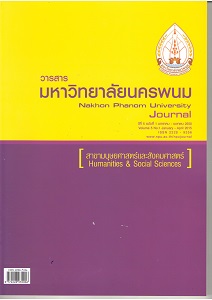การเปรียบเทียบผลสัมฤทธิ์ทางการเรียนและทักษะด้านฐานสมรรถนะวิชาชีพ ในรายวิชา คอมพิวเตอร์เพื่องานอาชีพ เรื่อง การใช้งานโปรแกรม Microsoft Office Excel 2007 สำหรับนักเรียนระดับประกาศนียบัตรวิชาชีพชั้นปีที่ 2 สาขาวิชาคอมพิวเตอร์ธุรกิจ ที่เรียนด้วยบทเรียนบนเครือ
Main Article Content
Abstract
การวิจัยนี้มีวัตถุประสงค์เพื่อ 1) พัฒนาบทเรียนบนเครือข่ายแบบ T5 Model ที่มีประสิทธิภาพและประสิทธิผลตามเกณฑ์ 85/85 โดยใช้สูตร E1/E2 และ E.I 2) เปรียบเทียบผลสัมฤทธิ์ทางการเรียนก่อนเรียนและหลังเรียน 3) เปรียบเทียบผลสัมฤทธิ์ทาง การเรียนที่เรียนด้วยบทเรียนบนเครือข่าย กับการเรียนแบบปกติ กลุ่มตัวอย่าง คือ นักเรียนระดับประกาศนียบัตรวิชาชีพชั้นปีที่ 2 วิทยาลัยเทคนิคน้ำพอง 50 คน โดยการสุ่มแบบกลุ่ม แบ่งเป็นกลุ่มทดลอง 25 คน จัดการเรียนโดยบทเรียนบนเครือข่ายแบบ T5 Model และ กลุ่มควบคุม 25 คน เรียนแบบปกติ เครื่องมือที่ใช้ในการวิจัยได้แก่ บทเรียนบนเครือข่าย T5 Model แผนการจัดการเรียนรู้ แบบทดสอบวัดผลสัมฤทธิ์ทางการเรียนมีค่าความยาก ตั้งแต่ 0.60 ถึง 0.76 มีค่าอำนาจจำแนก 0.25 ถึง 0.50 มีค่าความเชื่อมั่นเท่ากับ 0.79 และแบบทดสอบ มีค่าความยาก 0.60 ถึง 0.80 ค่าอำนาจจำแนก 0.25 ถึง 0.58 และค่าความเชื่อมั่นเท่ากับ 0.79 สถิติที่ใช้ใน การวิเคราะห์ข้อมูล ได้แก่ ค่าเฉลี่ย ส่วนเบี่ยงเบนมาตรฐาน การวิเคราะห์สมมติฐานใช้ Hotelling T2
ผลการวิจัยพบว่า 1) บทเรียนบนเครือข่ายแบบ T5 Model มีประสิทธิภาพเท่ากับ 82.56/88.80 2) ค่าดัชนีประสิทธิผล คิดเป็น ร้อยละ 82.50 3) นักเรียนกลุ่มทดลองมีผลสัมฤทธิ์ทางการเรียน สูงกว่านักเรียนกลุ่มควบคุม ที่สอนตามปกติอย่างมีนัยสำคัญทางสถิติที่ ระดับ .01 และ 4) นักเรียนมีผลสัมฤทธิ์ทางการเรียนหลังเรียนสูงกว่าก่อนเรียน อย่างมีนัยสำคัญทางสถิติที่ระดับ .01
This study aimed: 1) to develop a lesson on the T5 Model Networks, whose efficiency by the E1/E2 formula was set at 85/85 criterion and also to find its effectiveness index, 2) to compare students’ learning achievements gained before and after learning, 3) to compare students’ achievements in learning through the lesson on networks versus the traditional approach. A sample was 50 second year students of vocational certificate level at Namphong Technological College selected by cluster random sampling. The treatment group of 25 students was managed by the T5 Model Networks lesson, while the control group by traditional learning. The instruments used in the study were a lesson on the T5 Model Networks, a learning organization plan, a learning achievement test whose difficulty values ranged from 0.60 to 0.76, discrimination power values from 0.25 to 0.50 and reliability value was 0.79, and a test whose difficulty values ranged from 0.60 to 0.80, discrimination power values from 0.25 to 0.58 and reliability value was 0.79. Statistics used to analyze data were mean, standard deviation, Hotelling T2 for hypothesis testing.
The findings showed: 1) that the T5 Model Networks lesson had efficiency of 82.56/88.80; 2) that the effectiveness index value was 82.50 percent; 3) that the students of treatment group had a significantly higher learning achievement than those of control group who were taught by traditional approach at the .01 level of confidence, and 4) that the students had learning achievement after learning higher than that before learning at the .01 level of significance.


